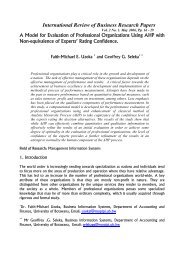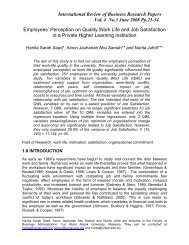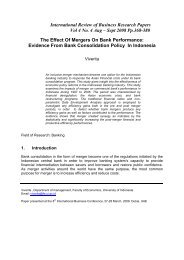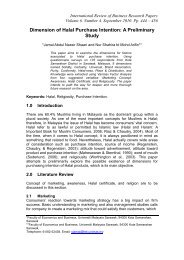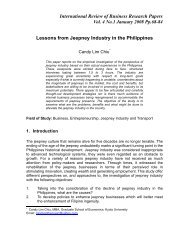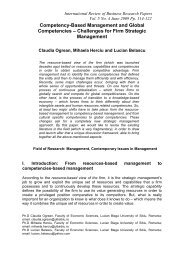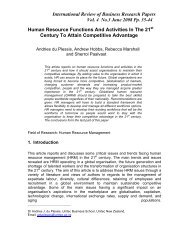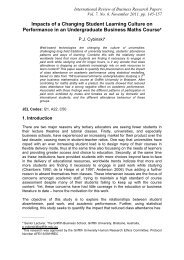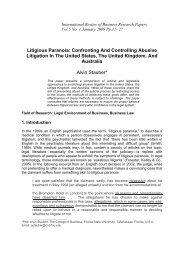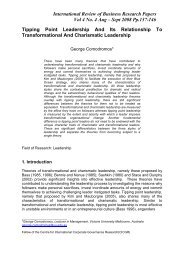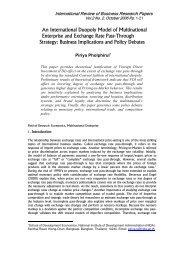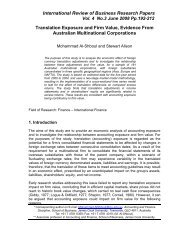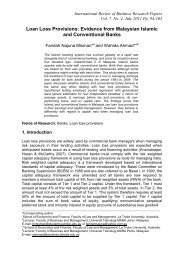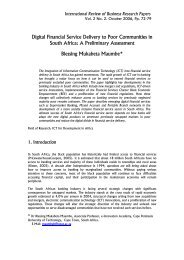Firm Performance and Corporate Governance Through Ownership ...
Firm Performance and Corporate Governance Through Ownership ...
Firm Performance and Corporate Governance Through Ownership ...
You also want an ePaper? Increase the reach of your titles
YUMPU automatically turns print PDFs into web optimized ePapers that Google loves.
Imam & Malik 93<br />
Karl V. Lins (2002) investigates whether management ownership structures <strong>and</strong> large<br />
non-management blockholders are related to firm value across a sample of 1433 firms<br />
from 18 emerging markets. He finds that large non-management control rights<br />
blockholdings (having more control rights) are positively related to firm value measured<br />
by Tobin’s Q. He also provides evidence that large non management blockholders can<br />
mitigate the valuation discounts associated with the expected agency problem.<br />
In 1985, Demstez <strong>and</strong> Lehn argued both that the optimal corporate ownership structure<br />
was firm specific, <strong>and</strong> that market competition would derive firms toward that optimum.<br />
Because ownership was endogenous to expected performance, they cautioned, any<br />
regression of profitability on ownership patterns should yield insignificant results.<br />
Yoshiro Miwa <strong>and</strong> Mark Ramseyer (February 2001) stated with a sample of 637<br />
Japanese firms <strong>and</strong> confirmed the equilibrium mechanism behind Demstez-Lehn.<br />
Using a sample of 144 Israeli firms, Beni Lauterbach1 <strong>and</strong> Efrat Tolkowsky (June 2004)<br />
find that Tobin's Q is maximized when control group vote reaches 67%. This evidence is<br />
strong when ownership structure is treated as exogenous <strong>and</strong> weak when it is<br />
considered endogenous.<br />
Steen Thomsen <strong>and</strong> Torben Pedersen (1997) examine the impact of ownership<br />
structure on company economic performance in the largest companies from 12<br />
European nations. According to their findings the positive marginal effect of ownership<br />
ties to financial institutions is stronger in the market-based British system than in<br />
continental Europe.<br />
Christoph Kaserer <strong>and</strong> Benjamin Moldenhauer (September 2005) address the question<br />
whether there is any empirical relationship between corporate performance <strong>and</strong> insider<br />
ownership. Using a data set of 245 Germen firms for the year 2003 they find evidence<br />
for a positive <strong>and</strong> significant relationship between corporate performance, as measured<br />
by stock price performance as well as by Tobin’s Q, <strong>and</strong> insider ownership.<br />
Michael L Lemmon <strong>and</strong> Karl V Lins ( August 2003) use a sample of 800 firms in eight<br />
East Asian countries to study the effect of ownership structure on value during the<br />
region’s financial crisis. The crisis negatively impacted firm’s investment opportunities,<br />
raising the incentives of controlling shareholders to expropriate minority investors. The<br />
evidence is consistent with the view that ownership structure plays an important role in<br />
determining whether insiders expropriate minority shareholders.<br />
3. Hypothesis to be tested<br />
This section provides an overview of the hypotheses. Regarding the determinants of the<br />
firm’s performance the following arguments <strong>and</strong> hypothesis can be developed:<br />
As ownership pattern varies across the firms, monitoring, controlling as well as<br />
execution of disciplining decision also changes. Different firms have ownership pattern.<br />
Some firms have sponsors as the largest shareholders; some have institutional or<br />
93



